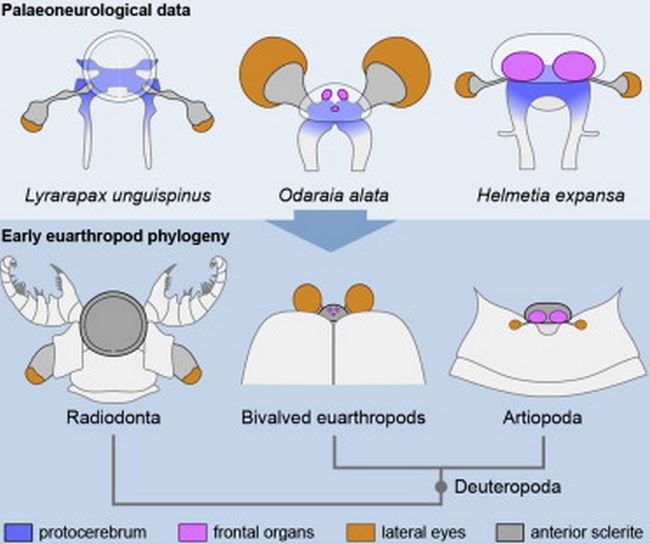How did heads first evolve in early animals? The discovery of a 500 million-year-old fossilised brain may provide insight into identifying a point of crucial transformation in animals many hundreds of millions of years ago, a scientist from the University of Cambridge in England said.
Dr. Javier Ortega-Hernández, a postdoctoral researcher from Cambridge’s Department of Earth Sciences, and colleagues say their findings identify a key point in the evolutionary transition from soft to hard body in the early ancestors of arthropods – the group that contains modern spiders, crustaceans and insects.
Dr. Ortega-Hernández, who wrote about his findings in the academic journal Current Biology, looked at two types of arthropod ancestors – a strange creature that looked like a submarine, and a soft-bodied trilobite.

Odaraia alata, an arthropod resembling a submarine from the middle Cambrian Burgess Shale. (Image: University of Cambridge)
He found that the anterior sclerite (a hard plate), and eye-like features at the front of their bodies were connected through nerve traces coming from the front part of the brain, which corresponds with how modern arthropods see things.
The new results also allowed new comparisons with a group of large swimming predators of the period called anomalocaridids, and found key similarities between the anterior sclerite and a plate located on the top of the anomalocaridid head, suggesting that the different species had a common origin.
Even though most scientists agree that anomalocaridids are early arthropod ancestors, their bodies are, in fact, quite different.
Thanks to the preserved brains in these fossil specimens, scientists can now recognise the anterior sclerite as a bridge between the head of anomalocaridids and that of the jointed arthropods we are more familiar with.
Transition from soft to hard bodies
Dr Javier Ortega-Hernández said:
“The anterior sclerite has been lost in modern arthropods, as it most likely fused with other parts of the head during the evolutionary history of the group.”
“What we’re seeing in these fossils is one of the major transitional steps between soft-bodied worm-like creatures and arthropods with hard exoskeletons and jointed limbs – this is a period of crucial transformation.”
The researchers observed that bright spots at the front of the bodies, which are actually simple photoreceptors, are embedded into the anterior sclerite.
The photoreceptors are connected to the anterior part of the fossilised brain, similar to the arrangements found in modern arthropods.

Image: cell.com
Most likely, these ancient brains processed data like in modern arthropods, and were vital for interacting with the environment, escaping from predators, and detecting food.
The Cambrian Explosion
Arthropods with hard exoskeletons and jointed limbs first started to emerge about 500 million years ago, during the Cambrian Explosion, known as a period of rapid evolutionary innovation.
Before the Cambrian Explosion, most animal life forms on Earth consisted of soft-bodied creatures that looked like jellyfish or algae.
These fossils, from the collections of the Smithsonian Institution in Washington DC and the Royal Ontario Museum in Toronto, came from the Burgess Shale in Western Canada, one of the richest fossil sources from the period.
Understanding how brains evolved is very difficult, given that they consist of soft tissues that are essentially fatty-like substances that do not fossilise well.
Even in the Burgess Shale, where soft tissue fossilised samples are relatively abundant, finding brain tissue is very uncommon.
Dr. Ortega-Hernández said:
“Heads have become more complex over time. But what we’re seeing here is an answer to the question of how arthropods changed their bodies from soft to hard.”
“It gives us an improved understanding of the origins and complex evolutionary history of this highly successful group.”
The study was funded by Emmanuel College, Cambridge.
In a separate study, Dr. Martin Smith, Junior Research Fellow at the University of Cambridge’s Department of Earth Sciences, announced earlier this week that he and his team had discovered a new species of Penis Worm. The fossil had also been unearthed at Burgess Shale and existed 500 million years ago. It could turn its mouth inside out, revealing a throat lined with tiny teeth, resembling a cheese grater.
Citation: “Homology of Head Sclerites in Burgess Shale Euarthropods,” Javier Ortega-Hernánde. Current Biology. DOI: 10.1016/j.cub.2015.04.034.
